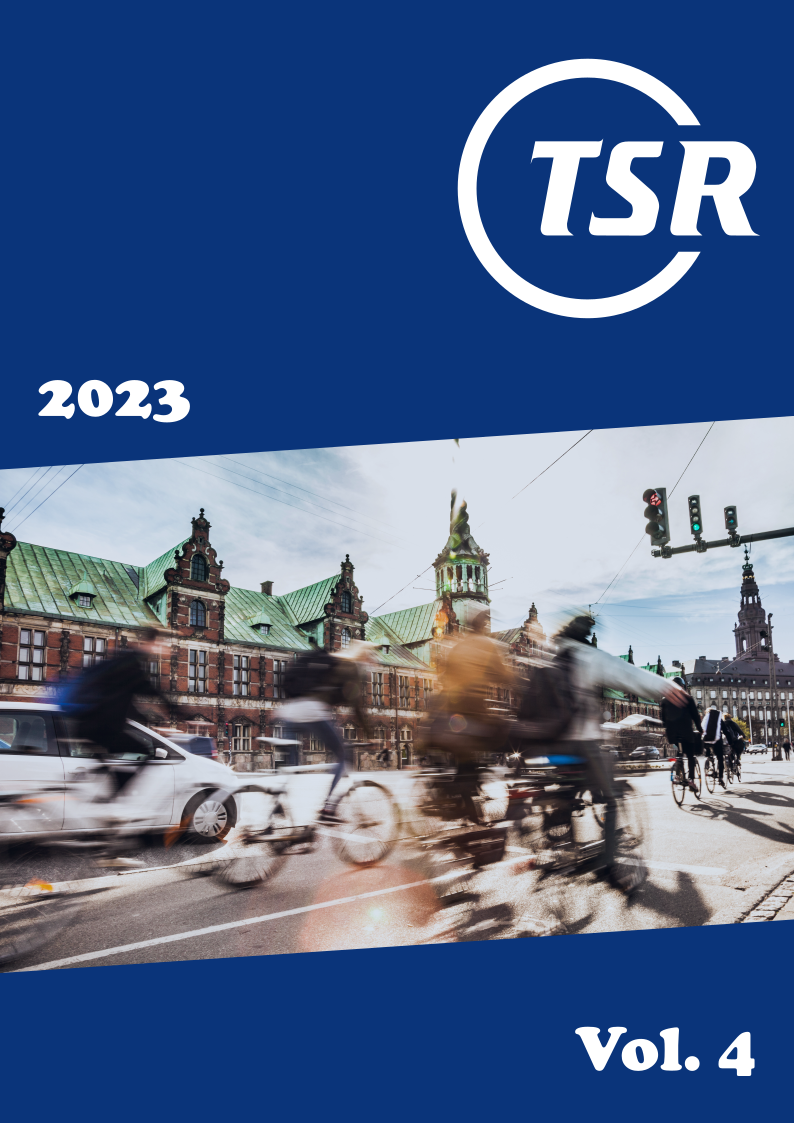Motivations of pedestrians for safe use of highway crossing: an application of the behaviour change model COM-B in Bangladesh
DOI:
https://doi.org/10.55329/apul4688Keywords:
COM-B model, crossing facilities, LMICs, road fatalities, safe crossing behaviourAbstract
In Low- and Middle-Income Countries (LMICs), approximately 93% of global road fatalities occur. As the population of students and workers in these countries continues to grow, walking becomes a prevalent mode of transportation for their daily commutes to schools and workplaces. Bangladesh faces the challenge of pedestrian fatalities, particularly among students and workers, while they cross medium-to-high speed roads during their daily journeys. This research aims to enhance highway crossing design and promote safe crossing behaviour in Bangladesh. The study utilises the COM-B (Capability, Opportunity, and Motivation-Behaviour) model to collect self-reported attitudinal responses from 302 pedestrians who regularly encounter different crossings, including zebra crossings, footbridges, underpasses, and non-priority crossings. These data collection sites are situated along two major highways in Bangladesh. The developed conceptual model in this study focuses on understanding the interplay between Capability, Opportunity, and Motivation, explaining 42% of the variance in the Target Behaviour of safe crossing use and 34.5% in Motivation. The analysis underscores the crucial role of Opportunity in predicting safe crossing use, followed by Motivation and Capability. Furthermore, the study examines the influence of COM-B factors on three essential components of the Target Behaviour: avoiding violations in using nearby crossings, aggressions, and lapses. The findings indicate that physical opportunity plays a vital role in avoiding violations in using nearby crossings, while social opportunity plays a vital role in avoiding aggressions and lapses. Motivation is a key mediator between Capability and Opportunity when predicting safe crossing use. To promote safe crossing practices, designers should focus on Motivation factors such as satisfaction, benefits realisation, and habit formation to maximise the benefits. The study emphasises the necessity for comprehensive interventions, which involve designing pedestrian-friendly infrastructure through various measures. These measures include improving visibility, reducing crossing times, ensuring accessibility, strategically placing traffic signs and fencing, and incorporating refuge areas. Additionally, the study highlights the significant role of social opportunities in safe crossing use by considering appropriate strategies to leverage social elements to motivate pedestrians by involving influential individuals, collaborating with families and institutions, facilitating group crossings, and implementing safety alert reminders. Moreover, social elements impact pedestrians' physical and psychological capabilities for safe crossing practice, as revealed in the study. Overall, the study highlights the potential of the COM-B model and underscores the need for comprehensive interventions to enhance pedestrian safety in LMICs.
Downloads
References
Adriaanse, M. A., P. M. Gollwitzer, D. T. De_Ridder (2011), 'Breaking habits with implementation intentions: A test of underlying processes', Personality and Social Psychology Bulletin, 37(4), 502–513. DOI: https://doi.org/10.1177/0146167211399102
Ahmed, I., B. Ahmed, M. R. Hainin (2014), 'Road traffic accident characteristics in Dhaka, Bangladesh', Jurnal Teknologi, 71(3), 75–82. DOI: https://doi.org/10.11113/jt.v71.3763
Amini, R. E., C. Katrakazas, C. Antoniou (2019), 'Negotiation and decision-making for a pedestrian roadway crossing: A literature review', Sustainability, 11(23), 6713. DOI: https://doi.org/10.3390/su11236713
Amiour, Y., E. O. D. Waygood, P. E. W. van den Berg (2022), 'Objective and perceived traffic safety for children: A systematic literature review of traffic and built environment characteristics related to safe travel', International Journal of Environmental Research and Public Health, 19(5), 2641. DOI: https://doi.org/10.3390/ijerph19052641
Anciaes, P. R., P. Jones (2018), 'Estimating preferences for different types of pedestrian crossing facilities', Transportation Research Part F: Traffic Psychology and Behaviour, 52, 222–237. DOI: https://doi.org/10.1016/j.trf.2017.11.025
Anderson, D. S. (2011), 'Chapter 30 - Persuasion and Motivational Messaging', in B E Porter, (ed.), Handbook of Traffic Psychology, (Cambridge, Massachusetts, US: Academic Press). DOI: https://doi.org/10.1016/B978-0-12-381984-0.10030-X
Antic, B., D. Pešsic, N. Milutinovic, M. Maslacc (2016), 'Pedestrian behaviours: Validation of the Serbian version of the pedestrian behaviour scale', Transportation Research Part F: Traffic Psychology and Behaviour, 41, 170–178. DOI: https://doi.org/10.1016/j.trf.2016.02.004
Asakura, S., G. Makingi, K. John (2022), 'Use of a participatory method for community-based brucellosis control design in agro-pastoral areas in Tanzania', Frontiers in Veterinary Science, 9. DOI: https://doi.org/10.3389/fvets.2022.767198
Bargh, J., R. Wyer, T. Srull (1994), Handbook of social cognition: Basic processes, (London, UK: Taylor & Francis Group).
Barker, F., L. Atkins, S. de_Lusignan (2016), 'Applying the COM-B behaviour model and behaviour change wheel to develop an intervention to improve hearing-aid use in adult auditory rehabilitation', International Journal of Audiology, 55(3), 90–98. DOI: https://doi.org/10.3109/14992027.2015.1120894
Bartolomeos, K., P. Croft, S. Job (2013), 'Pedestrian safety: A road safety manual for decision-makers and practitioners', World Health Organization.
Batool, Z. (2012), 'Attitudes towards road safety and aberrant behaviour of drivers in Pakistan', PhD thesis, The University of Leeds, Institute for Transport Studies, UK.
Becker, J. M., C. M. Ringle, M. Sarstedt, F. Völckner (2015), 'How collinearity affects mixture regression results', Marketing Letters, 26(4), 643–659. DOI: https://doi.org/10.1007/s11002-014-9299-9
Bin, N. R. (2014), 'Rising trend of work-related commuting accidents, deaths, injuries and disabilities in developing countries: a case study of Malaysia', Industrial Health, 52(4), 275–277. DOI: https://doi.org/10.2486/indhealth.52-275
Butler, A. A., S. R. Lord, R. C. Fitzpatrick (2016), 'Perceptions of speed and risk: Experimental studies of road crossing by older people', PLOS ONE, 11(4). DOI: https://doi.org/10.1371/journal.pone.0152617
Buttle, F. (1996), 'SERVQUAL: review, critique, research agenda', European Journal of Marketing, 30(1), 8–32. DOI: https://doi.org/10.1108/03090569610105762
Camara, F., N. Bellotto, S. Cosar (2020), 'Pedestrian models for autonomous driving part I: low-level models, from sensing to tracking', IEEE Transactions on Intelligent Transportation Systems, 22(10), 6131–6151. DOI: https://doi.org/10.1109/TITS.2020.3006768
Cane, J., D. Connor, S. Michie (2012), 'Validation of the theoretical domains framework for use in behaviour change and implementation research', Implementation Science, 7(1), 1–17. DOI: https://doi.org/10.1186/1748-5908-7-37
Carvalho, F., G. T. Jun, V. Mitchell (2017), 'Participatory design for behaviour change: An integrative approach to healthcare quality improvement', 7th International Congress of the International Association of Societies of Design Research, Cincinnati, Ohio, USA, 31 October–3 November 2017.
Cohen, P., S. G. West, L. S. Aiken (2014), Applied Multiple Regression/Correlation Analysis for the Behavioral Sciences, (London, UK: Psychology Press). DOI: https://doi.org/10.4324/9781410606266
Deb, S., L. Strawderman, J. DuBien (2017), 'Evaluating pedestrian behavior at crosswalks: Validation of a pedestrian behavior questionnaire for the U.S. population', Accident Analysis & Prevention, 106, 191–201. DOI: https://doi.org/10.1016/j.aap.2017.05.020
Deb, S., L. J. Strawderman, D. W. Carruth (2018), 'Investigating pedestrian suggestions for external features on fully autonomous vehicles: A virtual reality experiment', Transportation Research Rart F: Traffic Psychology and Behaviour, 59, 135–149. DOI: https://doi.org/10.1016/j.trf.2018.08.016
Deckers, L. (2018), Motivation: Biological, psychological, and environmental, (London, UK: Routledge). DOI: https://doi.org/10.4324/9781315178615
Dommes, A., V. Cavallo, J. B. Dubuisson (2014), 'Crossing a two-way street: comparison of young and old pedestrians', Journal of Safety Research, 50, 27–34. DOI: https://doi.org/10.1016/j.jsr.2014.03.008
Di´az, E. M. (2002), 'Theory of planned behavior and pedestrians' intentions to violate traffic regulations', Transportation Research Part F: Traffic Psychology and Behaviour, 5(3), 169–175. DOI: https://doi.org/10.1016/S1369-8478(02)00015-3
Ettema, D., T. Gärling, L. Eriksson (2011), 'Satisfaction with travel and subjective well-being: Development and test of a measurement tool', Transportation Research Part F: Traffic Psychology and Behaviour, 14(3), 167–175. DOI: https://doi.org/10.1016/j.trf.2010.11.002
Evans, D., P. Norman (2003), 'Predicting adolescent pedestrians’ road-crossing intentions: An application and extension of the Theory of Planned Behaviour', Health Education Research, 18(3), 267–277. DOI: https://doi.org/10.1093/her/cyf023
Evans, D., P. Norman (1998), 'Understanding pedestrians' road crossing decisions: An application of the theory of planned behaviour', Health Education Research, 13(4), 481–489. DOI: https://doi.org/10.1093/her/13.4.481-a
Falk, R. F., N. B. Miller (1992), A Primer for Soft Modeling, (Akron US: University of Akron Press).
Fujii, S., T. Gärling (2005), 'Temporary structural change: A strategy to break car-use habit and promote public transport', International Conference of Traffic and Transport Psychology, Nottingham, England, September 2004. DOI: https://doi.org/10.1016/B978-008044379-9/50202-8
Fylan, F. (2017), Using Behaviour Change Techniques: Guidance for the road safety community, (Perth, Australia: RAC Foundation).
Galesic, M., M. Bosnjak (2009), 'Effects of questionnaire length on participation and indicators of response quality in a web survey', Public Opinion Quarterly, 73(2), 349–360. DOI: https://doi.org/10.1093/poq/nfp031
Gollwitzer, P. M. (1999), 'Implementation intentions: Strong effects of simple plans', American Psychologist, 54(7), 493–503. DOI: https://doi.org/10.1037//0003-066X.54.7.493
Granié, M.-A., M. Pannetier, L. Gueho (2013), 'Developing a self-reporting method to measure pedestrian behaviors at all ages', Accident Analysis & Prevention, 50, 830–839. DOI: https://doi.org/10.1016/j.aap.2012.07.009
Guo, H., F. Zhao, W. Wang (2014), 'Modeling the perceptions and preferences of pedestrians on crossing facilities', Discrete Dynamics in Nature and Society, 2014, 1–8. DOI: https://doi.org/10.1155/2014/949475
Haghani, M., A. Behnood, V. Dixit, O. Oviedo-Trespalacios (2022), 'Road safety research in the context of low- and middle-income countries: Macro-scale literature analyses, trends, knowledge gaps and challenges', Safety Science, 146, 105513. DOI: https://doi.org/10.1016/j.ssci.2021.105513
Hamed, M. M. (2001), 'Analysis of pedestrians’ behavior at pedestrian crossings', Safety Science, 38(1), 63–82. DOI: https://doi.org/10.1016/S0925-7535(00)00058-8
Harrison, W. A. (2008), 'Psst-you know they're not the same as us: a psychologist's view of motivation and behaviour change in relation to high risk road users', Joint ACRS-Travelsafe National Conference.
Hasan, R., M. Napiah (2018), 'The perception of Malaysian pedestrians toward the use of footbridges', Traffic Injury Prevention, 19(3), 292–297. DOI: https://doi.org/10.1080/15389588.2017.1373768
Hendricks, M. J., F. M. Moghaddam (2020), 'Psychology for the global 99%', in Sundararajan, L., K.-K. Hwang, K.-H. Yeh (eds.), Global psychology from indigenous perspectives: Visions inspired by K. S. Yang, (London, UK: Palgrave Macmillan). DOI: https://doi.org/10.1007/978-3-030-35125-0_9
Hendriks, T., M. A. Warren, M. Schotanus-Dijkstra (2019), 'How weird are positive psychology interventions? A bibliometric analysis of randomized controlled trials on the science of well-being', The Journal of Positive Psychology, 14(4), 489–501. DOI: https://doi.org/10.1080/17439760.2018.1484941
Holm, A., J. Jaani, D. Eensoo, J. Piksööt (2018), 'Pedestrian behaviour of 6th grade Estonian students: Implications of social factors and accident-prevention education at school', Transportation Research Part F: Traffic Psychology and Behaviour, 52, 112–119. DOI: https://doi.org/10.1016/j.trf.2017.11.005
Hoque, M. S., A. K. Debnath, S. Mahmud (2006), 'Impact of garment industries on road safety in metropolitan Dhaka', International Conference on Traffic Safety in Developing Countries, Dhaka, Bangladesh, 22–24 August 2006.
Hughes, B., S. Newstead, A. Anund (2015), 'A review of models relevant to road safety', Accident Analysis & Prevention, 74, 250–270. DOI: https://doi.org/10.1016/j.aap.2014.06.003
Hung, M. F., C. T. Chang, D. Shaw (2019), 'Individuals’ intentions to mitigate air pollution: Vehicles, household appliances, and religious practices', Journal of Cleaner Production, 227, 566–577. DOI: https://doi.org/10.1016/j.jclepro.2019.04.163
ILO, (2005), 'Facts on Safety at Work', International Labour Organization.
iRAP, (2013), 'International Road assessment Programme Report', iRAP, TA-7840 BAN:ADB Road safety program.
ITE, (2006), 'Safe System', Institute of Transportation Engineers.
Jovanovic, D., P. Stanojevic, D. Stanojevic (2011), 'Motives for, and attitudes about, driving-related anger and aggressive driving', Social Behavior and Personality: an international journal, 39(6), 755–764. DOI: https://doi.org/10.2224/sbp.2011.39.6.755
Kadali, B. R., P. Vedagiri (2013), 'Modelling pedestrian road crossing behaviour under mixed traffic condition', European Transport, 55(3), 1–17.
Keyworth, C., T. Epton, J. Goldthorpe (2020), 'Acceptability, reliability, and validity of a brief measure of capabilities, opportunities, and motivations', British Journal of Health Psychology, 25(3), 474–501. DOI: https://doi.org/10.1111/bjhp.12417
Khorasani_Zavareh, D., R. Mohammadi, H. R. Khankeh (2009), 'The requirements and challenges in preventing of road traffic injury in Iran. A qualitative study', BMC Public Health, 9(1), 1–9. DOI: https://doi.org/10.1186/1471-2458-9-486
Kim, S., S. Park, J. S. Lee (2014), 'Meso-or micro-scale? Environmental factors influencing pedestrian satisfaction', Transportation Research Part D: Transport and Environment, 30, 10–20. DOI: https://doi.org/10.1016/j.trd.2014.05.005
Koh, P., Y. Wong, P. Chandrasekar (2014), 'Safety evaluation of pedestrian behaviour and violations at signalised pedestrian crossings', Safety Science, 70, 143–152. DOI: https://doi.org/10.1016/j.ssci.2014.05.010
Kouabenan, D. R. (2009), 'Role of beliefs in accident and risk analysis and prevention', Safety Science, 47(6), 767–776. DOI: https://doi.org/10.1016/j.ssci.2008.01.010
Kroll, J., E. Egan (2004), 'Psychiatry, moral worry, and the moral emotions', Journal of Psychiatric Practice, 10(6), 352–360. DOI: https://doi.org/10.1097/00131746-200411000-00003
Lawton, R., D. Parker, A. S. Manstead, S. G. Stradling (1997), 'The role of affect in predicting social behaviors: The case of road traffic violations', Journal of Applied Social Psychology, 27(14), 1258–1276. DOI: https://doi.org/10.1111/j.1559-1816.1997.tb01805.x
Lord, S., M. S. Cloutier, B. Garnier, Z. Christoforou (2018), 'Crossing road intersections in old age-with or without risks? Perceptions of risk and crossing behaviours among the elderly', Transportation Research Part F: Traffic Psychology and Behaviour, 55, 282–296. DOI: https://doi.org/10.1016/j.trf.2018.03.005
Lydon, S., C. Greally, O. Tujjar (2019), 'Psychometric evaluation of a measure of factors influencing hand hygiene behaviour to inform intervention', Journal of Hospital Infection, 102(4), 407–412. DOI: https://doi.org/10.1016/j.jhin.2019.02.003
Mcilroy, R. C., K. L. Plant, U. Jikyong (2019), 'Vulnerable road users in low-, middle-, and high-income countries: Validation of a pedestrian behaviour questionnaire', Accident Analysis & Prevention, 131, 80–94. DOI: https://doi.org/10.1016/j.aap.2019.05.027
Meltzoff, A. N., M. K. Moore (2002), 'Imitation, memory, and the representation of persons', Infant Behavior and Development, 25(1), 39–61. DOI: https://doi.org/10.1016/S0163-6383(02)00090-5
Mendonça, G., L. A. Cheng, E. N. Mélo, J. C. de_Farias_Júnior (2014), 'Physical activity and social support in adolescents: a systematic review', Health Education Research, 29(5), 822–839. DOI: https://doi.org/10.1093/her/cyu017
Michail, N., A. Ozbil, R. Parnell, S. Wilkie (2021), 'Children’s experiences of their journey to school: Integrating behaviour change frameworks to inform the role of the built environment in active school travel promotion', International Journal of Environmental Research and Public Health, 18(9). DOI: https://doi.org/10.3390/ijerph18094992
Michie, S., L. Atkins, R. West (2014), The behaviour change wheel, (Sutton, Surrey, UK: Silverback Publishing).
Michie, S., M. Johnston, C. Abraham (2005), 'Making psychological theory useful for implementing evidence based practice: A consensus approach', BMJ Quality & Safety, 14(1), 26–33. DOI: https://doi.org/10.1136/qshc.2004.011155
Michie, S., M. M. van_Stralen, R. West (2011), 'The behaviour change wheel: A new method for characterising and designing behaviour change interventions', Implementation Science, 6(1), 1–12. DOI: https://doi.org/10.1186/1748-5908-6-42
Miller, J. G., T. K. Hartman, L. Levita (2020), 'Capability, opportunity, and motivation to enact hygienic practices in the early stages of the COVID-19 outbreak in the United Kingdom', British Journal of Health Psychology, 25(4), 856–864. DOI: https://doi.org/10.1111/bjhp.12426
Mistry, C. D., S. N. Sweet, A. E. Latimer-Cheung, R. E. Rhodes (2015), 'Predicting changes in planning behaviour and physical activity among adults', Psychology of Sport and Exercise, 17, 1–6. DOI: https://doi.org/10.1016/j.psychsport.2014.10.002
Mukherjee, D., S. Mitra (2020), 'Identification of pedestrian risk factors using negative binomial model', Transportation in Developing Economies, 6(1). DOI: https://doi.org/10.1007/s40890-019-0092-6
Muley, D., M. Kharbeche, W. Alhajyaseen, M. Al_Salem (2017), 'Pedestrians' crossing behavior at marked crosswalks on channelized right-turn lanes at intersections', Procedia Computer Science, 109, 233–240. DOI: https://doi.org/10.1016/j.procs.2017.05.339
Nag, D., E. Bhaduri, G. P. Kumar, A. K. Goswami (2020), 'Assessment of relationships between user satisfaction, physical environment, and user behaviour in pedestrian infrastructure', Transportation Research Procedia, 48, 2343–2363. DOI: https://doi.org/10.1016/j.trpro.2020.08.284
Newbury, C., K. Hsiao, R. Dansey, J. Hamill (2008), 'Paediatric pedestrian trauma: the danger after school', Journal of Paediatrics and Child Health, 44(9), 488–491. DOI: https://doi.org/10.1111/j.1440-1754.2008.01330.x
Niedderer, K., J. Mackrill, S. Clune (2014), 'Creating sustainable innovation through design for behaviour change: Full project report', Design for Behaviour Change.
Nordfjærn, T., M. F. Zavareh (2016), 'Individualism, collectivism and pedestrian safety: A comparative study of young adults from Iran and Pakistan', Safety Science, 87, 8–17. DOI: https://doi.org/10.1016/j.ssci.2016.03.005
Özkan, T., T. Lajunen (2005), 'A new addition to DBQ: Positive driver behaviours scale', Transportation Research Part F: Traffic Psychology and Behaviour, 8(4-5), 355–368. DOI: https://doi.org/10.1016/j.trf.2005.04.018
Perry, C., K. Chhatralia, D. Damesick (2015), 'Behavioural insights in health care: Nudging to reduce inefficiency and waste (Health Foundation)', The Health Foundation, ISBN: 978-1-906461-73-7.
Pruitt, D. G. (1986), 'Trends in the scientific study of negotiation and mediation', Negotiation Journal, 2, 237. DOI: https://doi.org/10.1111/j.1571-9979.1986.tb00361.x
Rasouli, A., I. Kotseruba, J. K. Tsotsos (2017), 'Understanding pedestrian behavior in complex traffic scenes', IEEE Transactions on Intelligent Vehicles, 3(1), 61–70. DOI: https://doi.org/10.1109/TIV.2017.2788193
Rasouli, A., J. K. Tsotsos (2020), 'Autonomous vehicles that interact with pedestrians: A survey of theory and practice', IEEE Transactions on Intelligent Transportation Systems, 21(3), 900–918. DOI: https://doi.org/10.1109/TITS.2019.2901817
Reason, J., A. Manstead, S. Stradling (1990), 'Errors and violations on the roads: A real distinction?', Ergonomics, 33(10-11), 1315–1332. DOI: https://doi.org/10.1080/00140139008925335
RHD, (2018), 'Study on road safety hazards including design of countermeasures at intersections on national and regional highways of Bangladesh', Roads & Highways Department, RHD/SE/RDSC/2018/1.
Ribbens, H. (2003), 'Strategies to promote the safety of vulnerable road users in developing and emerging countries: South African experience', Transportation Research Record, 1846(1), 26–30. DOI: https://doi.org/10.3141/1846-05
Robins, G. (2012), Praise, motivation and the child, (London, UK: Taylor & Francis Group). DOI: https://doi.org/10.4324/9780203117682
Salmon, P. M., G. J. Read, N. J. Stevens (2016), 'Who is in control of road safety? A stamp control structure analysis of the road transport system in Queensland, Australia', Accident Analysis & Prevention, 96, 140–151. DOI: https://doi.org/10.1016/j.aap.2016.05.025
Sarstedt, M., C. M. Ringle, J. F. Hair (2021), 'Partial least squares structural equation modeling', in Homburg, C., M. Klarmann, A. Vomberg (eds.), Handbook of Market Research, (Cham, Switzerland: Springer). DOI: https://doi.org/10.1007/978-3-319-05542-8_15-2
Schmidtke, K., K. Drinkwater (2021), 'A cross-sectional survey assessing the influence of theoretically informed behavioural factors on hand hygiene across seven countries during the COVID-19 pandemic', BMC Public Health, 21(1), 1–14. DOI: https://doi.org/10.1186/s12889-021-11491-4
Shi, J., Y. Chen, F. Ren, J. Rong (2007), 'Research on pedestrian behavior and traffic characteristics at unsignalized midblock crosswalk: Case study in Beijing', Transportation Research Record, 2038(1), 23–33. DOI: https://doi.org/10.3141/2038-04
Shove, E. (2010), 'Beyond the ABC: Climate change policy and theories of social change', Environment and Planning A: Economy and Space, 42(6), 1273–1285. DOI: https://doi.org/10.1068/a42282
Sisiopiku, V. P., D. Akin (2003), 'Pedestrian behaviors at and perceptions towards various pedestrian facilities: An examination based on observation and survey data', Transportation Research Part F: Traffic Psychology and Behaviour, 6(4), 249–274. DOI: https://doi.org/10.1016/j.trf.2003.06.001
Soliz, A., R. Pérez-López (2022), ' "Footbridges": pedestrian infrastructure or urban barrier?', Current Opinion in Environmental Sustainability, 55, 101161. DOI: https://doi.org/10.1016/j.cosust.2022.101161
Stapleton, S., T. Kirsch, T. J. Gates, P. T. Savolainen (2017), 'Factors affecting driver yielding compliance at uncontrolled midblock crosswalks on low-speed roadways', Transportation Research Record, 2661(1), 95–102. DOI: https://doi.org/10.3141/2661-11
Taylor, D., M. Bury, N. Campling, S. Carter, S. Garfied, J. Newbould, T. Rennie (2006), 'A review of the use of the Health Belief Model (HBM), the Theory of Reasoned Action (TRA), the Theory of Planned Behaviour (TPB) and the Trans-Theoretical Model (TTM) to study and predict health related behaviour change', National Institute for Health and Clinical Excellence.
Tekes, B., G. Solmazer, H. N. Alkan (2021), 'The relationship between traffic sign comprehension and risky traffic behaviors', Nesne Psikoloji Dergisi, 9(22), 755–769. DOI: https://doi.org/10.7816/nesne-09-22-01
Tiwari, G. (2020), 'Progress in pedestrian safety research', International Journal of Injury Control and Safety Promotion, 27(1), 35–43. DOI: https://doi.org/10.1080/17457300.2020.1720255
Tiwari, R. R., S. Patel, A. Soju, P. Trivedi (2021), 'Road use pattern and street crossing habits of schoolchildren in India', Frontiers in Public Health, 9. DOI: https://doi.org/10.3389/fpubh.2021.628147
Triandis, H. C. (1977), Interpersonal behavior, (Eagle River, US: Brooks/Cole Publishing Company).
Waldock, J. (2008), 'Mature driver behaviour change programmes in the United States of America, Sweden, Denmark & the Netherlands', Municipal Engineers Foundation Victoria, Study Tour Report 2007.
Wang, H., D. Tan, D. C. Schwebel (2018), 'Effect of age on children's pedestrian behaviour: Results from an observational study', Transportation Research Part F: Traffic Psychology and Behaviour, 58, 556–565. DOI: https://doi.org/10.1016/j.trf.2018.06.039
Webb, T. L., P. Sheeran (2006), 'Does changing behavioral intentions engender behavior change? A meta-analysis of the experimental evidence', Psychological Bulletin, 132(2), 249–268. DOI: https://doi.org/10.1037/0033-2909.132.2.249
Webb, T. L., F. F. Sniehotta, S. Michie (2010), 'Using theories of behaviour change to inform interventions for addictive behaviours', Addiction, 105(11), 1879–1892. DOI: https://doi.org/10.1111/j.1360-0443.2010.03028.x
West, R., S. Michie, P. Chadwick (2020), 'Achieving behaviour change, a guide for national government', Public Health England, GW-1674.
WHO, (2018), 'Global status report on road safety', World Health Organization.
World Bank, (2019), 'Road safety: An integral part of the World Bank's mission', The World Bank.
World Bank, (2020), 'Delivering road safety in Bangladesh: Leadership priorities and initiatives to 2030', The World Bank.
Xiao, Y., Y. Liu, Z. Liang (2021), 'Study on road-crossing violations among young pedestrians based on the Theory of Planned Behavior', Journal of Advanced Transportation, 2021. DOI: https://doi.org/10.1155/2021/6893816
Zhang, C., B. Zhou, G. Chen, F. Chen (2017), 'Quantitative analysis of pedestrian safety at uncontrolled multi-lane mid-block crosswalks in China', Accident Analysis & Prevention, 108, 19–26. DOI: https://doi.org/10.1016/j.aap.2017.08.018
Zheng, T., W. Qu, Y. Ge (2017), 'The joint effect of personality traits and perceived stress on pedestrian behavior in a Chinese sample', PLOS ONE, 12(11), 188153. DOI: https://doi.org/10.1371/journal.pone.0188153
Zhou, H., S. B. Romero, X. Qin (2016), 'An extension of the theory of planned behavior to predict pedestrians’ violating crossing behavior using structural equation modeling', Accident Analysis & Prevention, 95, 417–424. DOI: https://doi.org/10.1016/j.aap.2015.09.009
Zhou, R., W. J. Horrey, R. Yu (2009), 'The effect of conformity tendency on pedestrians’ road-crossing intentions in China: An application of the theory of planned behavior', Accident Analysis & Prevention, 41(3), 491–497. DOI: https://doi.org/10.1016/j.aap.2009.01.007
Published
How to Cite
Issue
Section
License
Copyright (c) 2023 M. Shaheen Sarker, Oliver Carsten, Yue Huang, Foroogh Hajiseyedjavadi

This work is licensed under a Creative Commons Attribution 4.0 International License.











